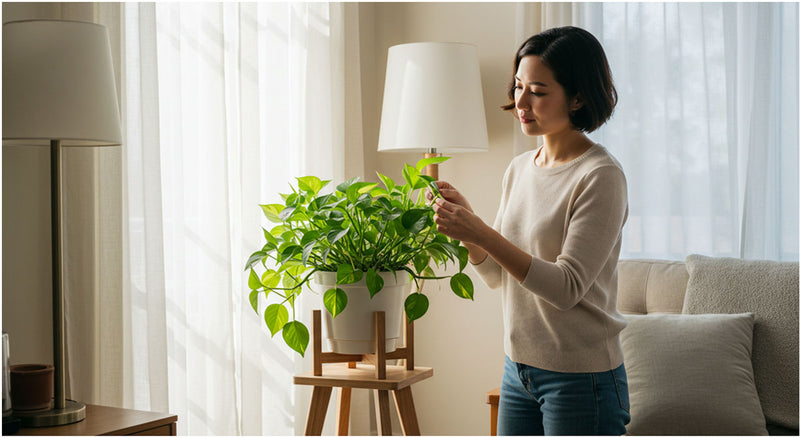Fix Yellow Spots on Pothos: Easy Solutions

If you've ever looked over at your pothos and spotted yellow blotches staring back at you, you're not alone. I remember the first time I noticed yellow spots creeping across the leaves of mine, and my heart sank. I had no idea what I was doing wrong or how serious it could be. The truth is, pothos are pretty forgiving plants, but yellowing is their way of waving a flag that something's off.
The good news is that most of the time, these problems aren't permanent. With a quick pothos health check and a few simple shifts in your care routine, you can get your plant back on track. The key is catching the signs early, figuring out what's causing the issue, and making tweaks that actually help your plant bounce back.

Common Causes of Yellow Spots on Pothos Plants
Yellow spots can mean a few different things. Sometimes it's a single issue, but often it's a mix of small things adding stress to your plant. Here are the most common reasons I've run into over the years.
1. Overwatering
This is probably the most common and easy-to-miss issue. When the soil stays too wet, the roots don't get the oxygen they need. That stress often starts showing up as yellow blotches, especially near the base of the plant. I've found that pots without drainage holes or watering too frequently are usually at the heart of it.
2. Nutrient Deficiencies
If your plant is in old soil or hasn't been fertilized in a while, it could be starving for nutrients like nitrogen or magnesium. That usually shows up as yellowing in patches or even whole leaves turning pale. A gentle, balanced fertilizer can usually get things back on track pretty quickly.
3. Pests Like Spider Mites or Mealybugs
These little troublemakers suck the juices out of leaves, leaving behind tiny yellow or white spots. I'll usually first spot the damage on new growth or the undersides of the leaves. A weekly check-up helps me catch them before they spread all over.
4. Too Much Direct Sun or Too Little Light
Pothos love a bright spot but not direct, burning sun. The leaves can get scorched, which shows up as crispy, yellowed spots. On the flip side, if they're too far from a window they might start fading, looking stretched out, or getting yellow from poor growth.
5. Cold Drafts or Sudden Temperature Swings
AC vents, heaters, or drafty windows can really mess with them. These shifts tend to stress out the plant, which often shows up in the leaves first. I make a habit of keeping my pothos in areas of my home where the temperature stays pretty stable.

Steps for a Pothos Health Check
The moment I spot something off about my pothos, I pause and go down the checklist. It helps me avoid guesswork and keeps me from making things worse.
- Look at the soil
If it feels wet several days after I've watered, or it smells stale or swampy, I know it's holding too much water. Switching to a lighter soil mix and backing off the watering schedule often clears it up.
- Check the pot's drainage
If the pot doesn't have drainage holes, that's a planting accident waiting to happen. Pothos hate sitting in soggy soil. I always double-check there's space for water to flow out the bottom freely.
- Inspect the leaves
I check both the tops and undersides. Tiny yellow dots could mean pests, while soft yellowing could point to rot. Sticky spots or fine webbing nearly always mean spider mites or scale have moved in.
- Look at the light
How many hours of daylight is it getting? Has the sun shifted with the seasons and now it's too harsh or too dim? I've had to move my plants around more than once as sunrise and sunset times change.
- Review your fertilizer routine
Too little food and your plant can't keep up good growth. Too much, and the salts can start to build up in the soil. I try to fertilize my pothos every couple of weeks during the warmer months, then ease off in the winter.
Once I go through this checklist, I usually find the root of the issue. And then I know exactly where to start adjusting my care.

Preventative Measures to Keep Pothos Healthy
Once I've helped my pothos recover, I focus on a few basics to avoid another setback. It's a habit now, and it makes such a difference.
Watering is where I always start. I never stick to a calendar. Instead, I use my finger to check the top inch or two of soil. If it's dry, I water deeply and let it drain. If it's still damp, I wait. That one switch helped me stop overwatering completely.
For nutrients, I use a gentle, all-purpose fertilizer during spring and summer. I've seen big improvements when I use one with calcium and magnesium—those two help build up the plant's defenses and reduce discoloration.
Light placement is huge. I stick to places with bright, indirect light like an east-facing window or a few feet back from a south-facing one. Harsh light really did a number on my pothos leaves before, so now I use sheer curtains or just pull the plant further from the window when the sun is intense.
I build a weekly pest check into my routine. A quick wipe-down of the leaves keeps dust and bugs away. If anything looks suspicious, I treat the plant right away with a water and mild soap solution. It's simple and saves lots of stress later on.
I mix my own soil so I know it drains well. That way, I'm not guessing what's inside a bag from the store. I blend basic indoor potting soil with perlite and coconut coir or peat moss. Every few months, I add worm castings to boost nutrients naturally.

When to Seek Professional Help
Sometimes, no matter what I try, things don't improve. When that happens, I don't wait too long to ask for help or get a second opinion.
Some warning signs I take seriously are:
- Roots that look brown, mushy, or smell off
- A lot of leaves yellowing at the same time
- Pests bouncing back after repeat treatments
- White crust on the top of the soil, which might be salt buildup
If any of these show up, I connect with an online plant group, message a local nursery, or contact someone who's had more plant experience than I do. A fresh perspective really does help spot problems I missed.
And if you're unsure, taking a break before adding anything else is often the best move. Trying too many fixes all at once can do more harm than good. Trust your gut and slow down the guessing game when things get worse, not better.
What Helped My Plant Bounce Back
Watching your pothos bounce back from yellowing spots feels like a win every time. These plants respond well to small changes, and once you find the cause, recovery can happen fast. That's what I love about them.
For me, fixing watering habits made the biggest difference. Swapping out old soil and staying consistent with fertilizer gave my plant the strength it needed to push out new leaves. And placing it in the right light—not too harsh, not too dim—keeps things steady.
I've learned that healthy pothos care doesn't have to take hours or special tools. Just a few habits—like checking light levels, wiping down leaves, and being smart about watering—go a long way. And before long, those yellow spots are gone and replaced with shiny, green growth again.
Once I got into a rhythm, taking care of my plant felt easy. The key was being patient, paying attention, and not ignoring little changes. Now, my pothos looks fuller than ever and keeps sending out new vines that I'm more than happy to let trail and climb all over my living room.
Ready to turn those yellow spots around and feel confident about your plant care routine? A simple adjustment often starts with doing a focused pothos health check to see what your plant is really asking for. At Houseplant Resource Center, we make it easy to give your green space what it needs to thrive with simple, proven tips and trusted products.




